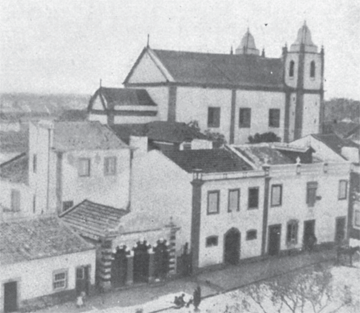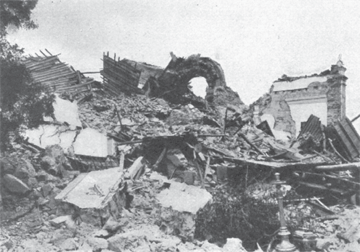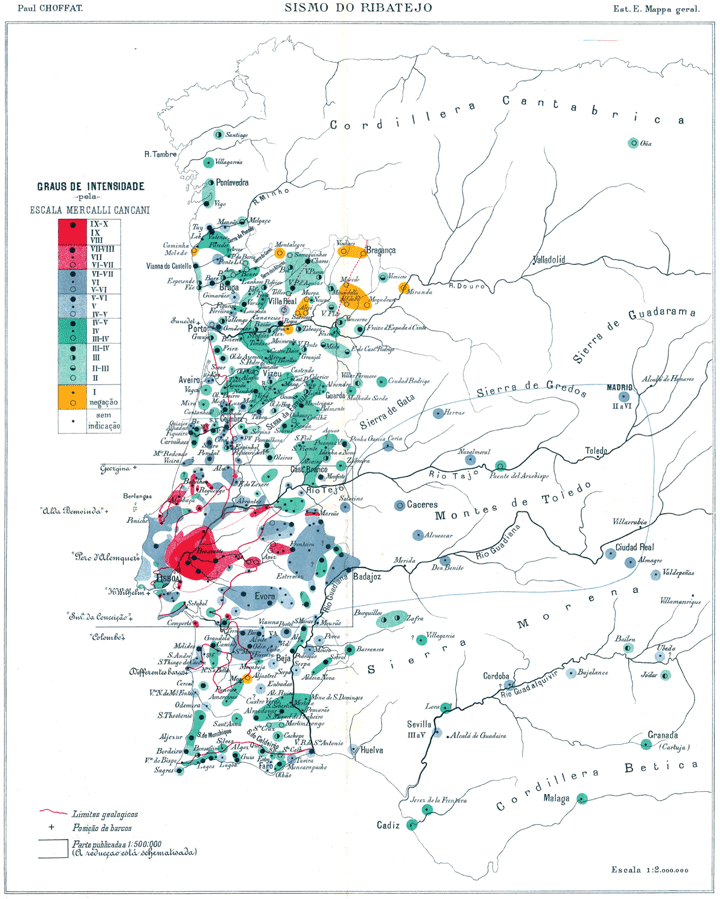| Publications: SRL: Historical Seismologist |
May/June 2010


▲ Figure 1. The Benavente parish church and surrounding buildings, before and after the 23 April 1909 earthquake. Photos by A. Franco, after Choffat and Bensaude (1912).
Click images to view full size.
The 23 April 1909 Benavente (Portugal) M 6.3 Earthquake
J. F. B. D. Fonseca
and S. P. Vilanova
Instituto Superior Tecnico, Lisbon
INTRODUCTION
Lisbon is forever linked to the history of seismology through the eponymous 1755 earthquake. But a less-known series of moderate to strong earthquakes, some with intraplate origin, has caused major destruction in the Lower Tagus Valley (LTV) region around the Portuguese capital throughout historical times. Although references to earthquakes can be found in coeval documents dating from the 14th century, the earliest descriptions of damage distribution with reasonable detail concern the 1531 Lisbon earthquake (Justo and Salwa 1998), with estimated moment magnitude of 6.9 (Vilanova and Fonseca 2007). In 1858, the town of Setubal, 30 km southeast of Lisbon, was shaken by a severe earthquake of estimated moment magnitude of 7.1 (Vilanova and Fonseca 2007) at what can be regarded as the southern limit of the LTV region. In 1909, the Benavente earthquake (Figure 1) clearly established the LTV region as a seismic source zone (Choffat and Bensaude 1912).
THE BENAVENTE EARTHQUAKE OF 1909
On 23 April 1909 at 5:03 p.m., the towns of Benavente, Samora Correia, and Santo Estevao (Figure 2), on the south margin of the Tagus river and ranging from 40 to 50 km to the northeast of Lisbon, were strongly shaken by a destructive earthquake that caused 47 fatalities. Three days after the event, an official commission was appointed to investigate the scientific and engineering aspects of the earthquake. The commission was headed by Paul Choffat, a prestigious geologist of Swiss origin. Alfredo Bensaude, future founder of Lisbon’s Instituto Superior Tecnico, was another prominent member of the commission, which published its conclusions in 1912 (Choffat and Bensaude 1912). In Benavente, a town of (at the time) 3,557 inhabitants, they reported that 40% of the buildings collapsed or had to be demolished, and another 40% required major repairs. In nearby Santo Estevao (832 inhabitants), only 46 out of 207 buildings could be recovered. A similar level of destruction was reported for Samora Correia (2,084 inhabitants). The rupture did not reach the surface, but many cracks in the alluvial plain of the Tagus were reported, frequently with sand ejection. An epicentral intensity of X on the Cancani (maximum XII) scale was estimated by Choffat, but the intensity decayed quickly to VI in Lisbon, 40 km away. The macroseismic intensity map of Choffat and Bensaude (1912), which is reproduced in Figure 2, shows the locations of the towns mentioned above.

▲ Figure 2. Isoseismal map of the 23 April 1909 earthquake, produced by Paul Choffat for the report of the scientific commission. The intensity scale used is Mercalli Cancani. The localities mentioned in the text, with intensities IX–X, are shown inside the inner contour as black dots. From the top and counterclockwise, they are: Benavente, Samora Correia, and Santo Estevao. Coruche, also shown toward the east, was assigned intensity VII–XIII. After Choffat and Bensaude (1912). Click image to view full size.
Moreira (1984) revised the epicentral intensity of the 1909 earthquake to IX on the Modified Mercalli scale of 1956 and estimated a focal depth of 4 km based on the isoseismal pattern. A modern estimate of the moment tensor using instruand Mw = 6.3 (Stich et al. 2005).
The limited number of fatalities in 1909 reflects the rural nature of the epicentral region at that time and the favorable circumstance that most people were at work in the fields at the time of the earthquake. The last 100 years have elapsed without a destructive earthquake with an epicenter near Lisbon. In view of the current concentration of population and infrastructures in the epicentral area, a repetition of the 1909 Benavente earthquake represents a major hazard and one for which the current awareness is low.
REFERENCES
Choffat, P., and A. Bensaude (1912). Estudos sobre o sismo do Ribatejo de 23 de Abril de 1909, Lisbon: Ed. Imprensa Nacional.
Justo, J. L., and C. Salwa (1998). The 1531 Lisbon earthquake. Bulletin of the Seismological Society of America 88, 319–328.
Moreira, V. (1984). Contribuicao para o conhecimento da sismicidade historica de Portugal Continental. Revista do Instituto Nacional de Meteorologia e Geofisica (special issue), Instituto Nacional de Meteorologia e Geofisica, Lisbon, Portugal.
Stich, D., J. Batllo, R. Macia, P. Teves-Costa, and J. Morales (2005). Moment tensor inversion with single-component historical seismograms: The 1909 Benavente (Portugal) and Lambesc (France) earthquakes. Geophysical Journal International 162, 850–858.
Vilanova, S. and J. Fonseca (2007). Probabilistic seismic-hazard assessment for Portugal. Bulletin of the Seismological Society of America 97, 1,702–1,717.

